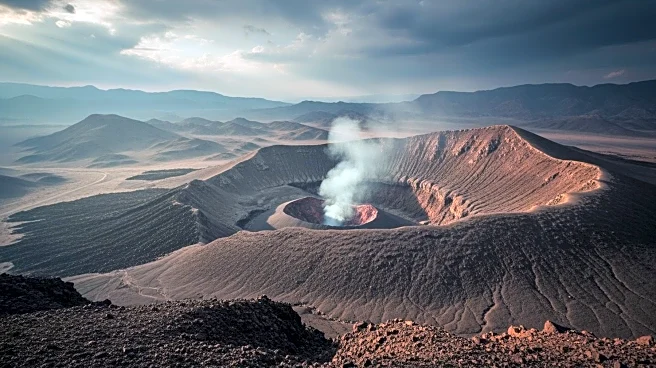What's Happening?
Mount Taftan, a dormant volcano located in the Makran region of southeastern Iran, is showing signs of potential activity. Recent satellite data has detected subtle swelling at the summit, indicating a possible buildup of magma and gas beneath the surface.
This development has raised alarms among scientists, as the volcano has not erupted in approximately 700,000 years. Mount Taftan is part of the continental volcanic arc formed by the subduction of the Arabian plate beneath the Eurasian plate. Despite its remote location, the volcano poses a potential threat to the surrounding region, which includes parts of Iran and Pakistan. Historically, the volcano has shown minimal signs of life, such as smoke emissions in 1902 and an unconfirmed lava flow in 1993. The recent findings suggest that Mount Taftan may not be as dormant as previously believed.
Why It's Important?
The potential reactivation of Mount Taftan could have significant implications for the local communities and infrastructure in the region. An eruption could disrupt daily life and cause considerable damage, particularly in remote villages and areas with critical infrastructure. The findings have prompted scientists to call for enhanced monitoring of the region to better understand the volcano's behavior and assess the risks. Strengthening local monitoring networks and updating geological risk maps are recommended to mitigate potential hazards. The situation underscores the importance of continuous monitoring in volcanically active areas, as even ancient volcanoes can experience unexpected changes.
What's Next?
Scientists are urging for increased surveillance and research to monitor Mount Taftan's activity closely. Enhanced monitoring networks and updated geological risk assessments are necessary to prepare for any potential volcanic activity. The scientific community is cautious about predicting an imminent eruption but emphasizes the need for vigilance given the recent changes. Local authorities may need to consider evacuation plans and infrastructure protection measures to safeguard communities in the event of an eruption.
Beyond the Headlines
The recent activity at Mount Taftan highlights the unpredictable nature of volcanic behavior and the challenges in forecasting eruptions. The absence of preceding signs such as earthquakes or weather disturbances makes it difficult to predict volcanic activity accurately. This situation raises questions about the adequacy of current monitoring technologies and the need for advancements in volcanic research. The findings also emphasize the importance of international collaboration in monitoring and managing volcanic risks, particularly in regions with shared geological features.















